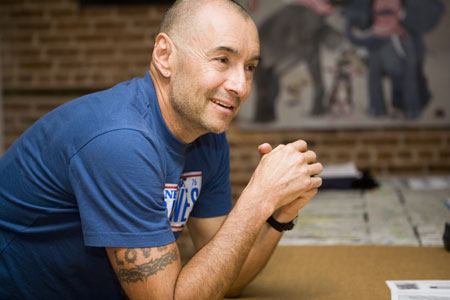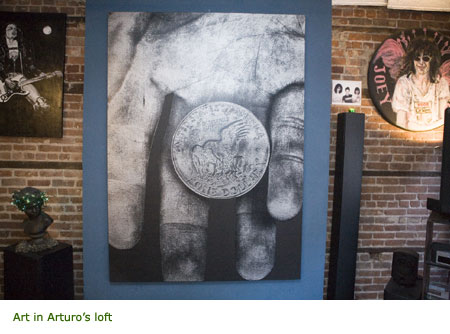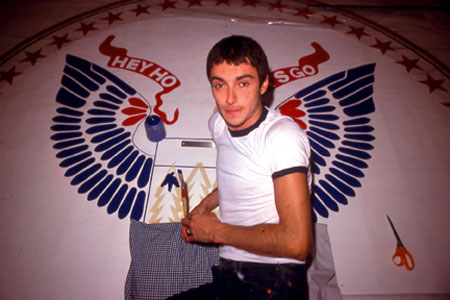
THE MAN BEHIND THE BLITZKRIEG:
FRINGE INTERVIEW WITH ARTURO VEGA
With Words by DEE DEE VEGA and Photos by SEAN FADER
As I rang the buzzer to Arturo Vega’s loft on a crisp morning in February—a buzzer with my name scrawled above it no
less—I was very aware that I was being invited into the birthplace of punk. Arturo Vega is the art director of the Ramones,
the band that became the legendary founding fathers of New York punk. He still occupies the loft on the Bowery that saw the
very conception of the last great American music scene some thirty years ago. Downtown art and style, or what’s left of it,
has experienced a multitude of changes since the days when the Ramones hit the streets with their relentless blitzkrieg of
assaulting guitar and hard edge style.
 Arturo met the Ramones in the early days when they were just a bunch of guys from Queens
with slip-ons and shitty instruments and engineered the aesthetic of the punk scene with his creation of the iconic Ramones
logo and look. Arturo has extremely soft and kind eyes that have undoubtedly seen a lot over the years. He and his dog greeted
photographer Sean Fader and I and lead us into “the loft.” The loft was actually an old plastic flower factory and in the early
seventies, Arturo was the first resident. He would paint with the door open and the wiry and tragically innocent Dee Dee Ramone
(then Douglas Colvin) would pop his head in to chat with Arturo. Dee Dee was forming a band, so he said. Did Arturo want to
help them? The rest is rock and roll history.
Arturo met the Ramones in the early days when they were just a bunch of guys from Queens
with slip-ons and shitty instruments and engineered the aesthetic of the punk scene with his creation of the iconic Ramones
logo and look. Arturo has extremely soft and kind eyes that have undoubtedly seen a lot over the years. He and his dog greeted
photographer Sean Fader and I and lead us into “the loft.” The loft was actually an old plastic flower factory and in the early
seventies, Arturo was the first resident. He would paint with the door open and the wiry and tragically innocent Dee Dee Ramone
(then Douglas Colvin) would pop his head in to chat with Arturo. Dee Dee was forming a band, so he said. Did Arturo want to
help them? The rest is rock and roll history.

Any Ramones fan has seen the old pictures of the days when Arturo Vega’s loft was home to Joey, Dee Dee and every other cool
person passing through—littered with mattresses on the floor and art in the air. Arturo and his extremely low-key canine lounged
back on a leather couch as he lamented for the essence of past days. “I take out my trash on the wrong day and my neighbors
are like ‘Arturo, this is not garbage day!’ This is the Bowery. Look at how it’s changed.” And it has. The past few years have
seen the death of Joey, Johnny and Dee Dee Ramone. But the Ramones iconic logo and merchandizing, which Arturo has continued to be the creative force behind, are
soaring in popularity. “It’s been a very slow process. It took, what, thirty years? And I have mixed feelings about it because
the problem is that the Ramones T-shirts turned out to be more popular—are right now more popular—than the music itself,” he
said. “But that is the sorry state of rock and roll at large. It’s a product used to sell other products. I don’t like the fact
that kids wear the T-shirts just because of fashion. I shouldn’t complain, since we’re doing better than ever. But it isn’t
satisfying to know that H&M in Europe sold hundreds of thousands of dollars worth of Ramones T-shirts. It was good when the T-shirt was selling because
people were coming to see the band.” As our conversation progressed, it became clear that for Arturo it was all about the music.

“I have been a rock and roll fan all my life. I heard Elvis when I was eight years old in 1955 on the radio in Chihuahua,”
(Mexico, where Vega is from), “I was playing with the short wave radio we had at home and heard something that didn’t sound
anything like what I had heard before… And in the sixties I followed rock and roll, literally. I traveled to see bands. I went
to San Francisco. Where else? I was in the Summer of Love. I was at Monterey Pop.” The most important point that kept surfacing
in our conversation is Arturo’s belief that rock and roll was the most important force, a revolutionary force in fact, shaping
culture. The rest of the pieces seemed to fall into place. Arturo came to New York in 1971 to perform in musical theatre. “I came
and I thought that that’s what I was going to do. I like theatre in a way. I like musicals. I like the spectacle. But I don’t
like theatre people. And I don’t like theatre acting.” To this I reply, “Get to the back of the line.”
 I asked Arturo about his connection to painting and design as well as the move to get involved with the Ramones. He said, “I never
wanted to be a professional anything because it kills everything else. Once you become a professional and specialize, it kills
the spirit of adventure and freedom. I realized a long time ago that what makes me free, makes me happy. What makes me free makes
me creative. So I never made art as a specialty. Like I said before, all I wanted to do was live my life according to certain
principles that make me have fun. I remember seriously thinking that having fun is part of what you do. You have to do. What you
should do. It’s part of educating yourself. There were some decisions. For example, I decided to stick with The Ramones. I was
already painting. I was making these large supermarket sign paintings and I thought, ‘Well, rock and roll is the most effective
art form of our day. If you want to change the world the best thing to do is work with young people. And young people listen to
rock and roll. So I’ll stop everything and stick with the Ramones. I think they’re going to go on.’ I had already seen what rock
and roll was like at the time. It was slowing down. When I saw the band and saw that they were different I thought, ‘This is a
movement.’ They could be the shot in the arm that rock and roll needs. I’ll stop everything else and work on this for a while.
I thought five years, ten years. There was some decision making, but how could you not? How could I pass up the possibility of
touring with a rock and roll band around the world to stay at home painting!”
I asked Arturo about his connection to painting and design as well as the move to get involved with the Ramones. He said, “I never
wanted to be a professional anything because it kills everything else. Once you become a professional and specialize, it kills
the spirit of adventure and freedom. I realized a long time ago that what makes me free, makes me happy. What makes me free makes
me creative. So I never made art as a specialty. Like I said before, all I wanted to do was live my life according to certain
principles that make me have fun. I remember seriously thinking that having fun is part of what you do. You have to do. What you
should do. It’s part of educating yourself. There were some decisions. For example, I decided to stick with The Ramones. I was
already painting. I was making these large supermarket sign paintings and I thought, ‘Well, rock and roll is the most effective
art form of our day. If you want to change the world the best thing to do is work with young people. And young people listen to
rock and roll. So I’ll stop everything and stick with the Ramones. I think they’re going to go on.’ I had already seen what rock
and roll was like at the time. It was slowing down. When I saw the band and saw that they were different I thought, ‘This is a
movement.’ They could be the shot in the arm that rock and roll needs. I’ll stop everything else and work on this for a while.
I thought five years, ten years. There was some decision making, but how could you not? How could I pass up the possibility of
touring with a rock and roll band around the world to stay at home painting!”
On to page 2 >
|




































